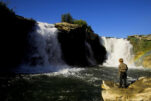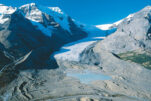Science Smarts: Rain, rain come again!
By PATTY ROOKS on June 4, 2022.
Well, it sure does not look like we are going to get some much needed rain anytime soon… I have resorted to making my own! Hopefully once we learn a bit more about the water cycle, we will understand why it is not raining?? Let’s get started! Remember to ask an adult before doing this experiment Materials • Electric kettle • Water • Metal spoon • Freezer • Oven mitt • Towels Procedure 1. Put your metal spoon in the freezer to keep it cold. 2. Put some water in a kettle and plug it in. 3. Once the water has been boiling for about one minute and there is steam escaping the mouth of the kettle, unplug it. 4. Remove the spoon from the freezer. 5. Put your oven mitt on AND have an adult help you with this step. Hold your spoon in the white vapour coming from the kettle and watch the rain fall. 6. Clean up your “rain” using the towels. Explanation First we need to know that the white vapour coming out of the kettle is not really steam as most of us think it is. Steam is invisible; you can see where it is if you look at the spout carefully there is a space between the spout and the white vapour. Then what is the white vapour that we can see? It is water vapour; the steam has cooled as it hits the cold air outside of the kettle to become water vapour that we can see. When you hold the cold spoon in the water vapour cloud, it cools the water vapour even more, making it condense onto the spoon as water. As more water collects on the spoon it falls off the spoon and starts raining in your kitchen. How does this relate to the real world and real rain? It has to do with the water cycle. Rain is made in the same fashion as we did in this experiment, it just takes a lot longer to happen. The sun works just like a kettle and heats up the water in the rivers, lakes, ponds and oceans all over the planet. It doesn’t heat the water up to boiling which is a good thing for the animals in the water! It gently warms the water enough for some molecules of water to evaporate and rise up into the sky. The water molecules rise into the sky in the air and as they rise into the atmosphere, they cool forming clouds that have lots of water vapour inside; just like the cloud of water vapour we formed when we boiled the water. Because cold air can’t hold as much water, the cloud gets pretty heavy and when there is too much water in the cloud, it is released back to earth as rain or snow. This happens over and over and over. Keep an eye on our social media as we have officially kicked off our 30th anniversary celebrations. June will be a busy month and we hope you will join us for this FREE community event on June 18 between 10 a.m. and 3 p.m. for our official celebration at the Carriage House. Patty Rooks, Senior Scientific Consultant PRAXIS, “Connecting Science To The Community”. Contact with Praxis at praxis@praxismh.ca, http://www.praxismh.ca, Tweet or follow us @PraxisMedHat, or friend us on Facebook. Address: #12 826 11 Street S. E., Medicine Hat, Alberta, T1A 1T7 Phone: 403.527.5365, email: praxis@praxismh.ca. 23-22




